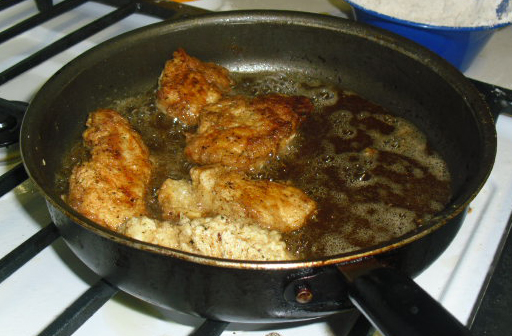Texas Pan-Fried Chicken: the misconception and the college-student friendly recipe

This archived article was written by: Toby Foster
Most of you have no idea who I am, so I will introduce myself before I start with the meat of this article. If you skipped the part where you are supposed to find the author’s name, I am Toby Foster, the rest of you can skip this sentence and get on with your lives.
I grew up in the small town of Portland, Texas. While attending Gregory-Portland High School, I took food science with my girlfriend. Now before you roll your eyes at my cliché life, I found that I love cooking because of this class and picked up some tricks that have helped me out since I moved out of my parents’ house.
What I want to do now is teach some of these tricks to make your survival of college a little more likely. In my column, I want to provide an affordable, tasty and easy recipe every issue, plus discuss some of the other things that can be done to either make it cheaper or healthier based on what you are most concerned about. And, for fun, I will throw in some trivia I have picked up about the food or researched to find out.
Now let’s talk about fried chicken. I grew up thinking fried chicken was the typical Sunday dinner of a Southern family after they got done at church. Turns out that stereotype is not all that accurate. Leftovers, however, is a popular choice. But once you start looking into recipes for fried chicken, the variety is almost endless. I have one that takes two days to be done properly and my brother-in-law likes to make his using cornflakes as the breading.
The biggest difference I have ever really been able to identify in making fried chicken is in how you make the breading stick to the chicken. The most fundamental way to do this is by dipping the chicken in eggs. My food science teacher even went as far as calling eggs “culinary glue” as it is used to keep hamburger patties and meatloaf, among other things, in one piece. Eggs are not super expensive, but can give a flat flavor to the chicken if not seasoned properly.
My favorite option, buttermilk, is more expensive, but rounds out the flavor more. Buttermilk is a classic among culinary circles. However it does not provide the same effectiveness in gluing the breading to the chicken; it instead will often let it slide right off the chicken while eating larger pieces.
That said, this recipe is egg based and built more for a college budget. I also decided to go with pan-frying over deep-frying to save on oil and make it healthier with less fat. You can use what ever oil you want to fry it that will have make almost no difference in the taste. I use canola oil because it is both cheap and healthy, but olive oil is healthier, and vegetable oil is cheaper. That said, here are the ingredients you will need:1 cup flour
1 tsp baking powder
1/2 tsp paprika
1/2 tsp garlic powder
1/2 tsp dill weed
1/4 tsp cumin
1/2 tsp salt
1/4 tsp pepper
1/2 oregano
4 uncooked, boneless, skinless chicken breasts
3 large eggs
1 cup cooking oil
Combine the flour, baking powder, paprika, garlic powder, dill weed, cumin, salt pepper and oregano in a bowl. Mix them together either with a fork or a whisk until everything is evenly mixed. Then cut the chicken into strips about an inch (about 2.5 cm) thick. Crack the eggs in another bowl and whip with a fork until the mixed evenly.
Put the oil in a medium frying pan and heat it over medium to medium low heat (this will vary from stove to stove). Put several strips into the eggs and then roll each strip in the flour mixture until coated evenly (do not allow to sit in the flour for more than a few seconds as the liquid will soak through the rest of the flour and make it start hardening).
Cook four to six strips in the pan at a time; cook them on both sides until they are a golden brown. Let them cool on a plate with a paper towel beneath them before serving. Enjoy with any dipping sauce your heart desires.




